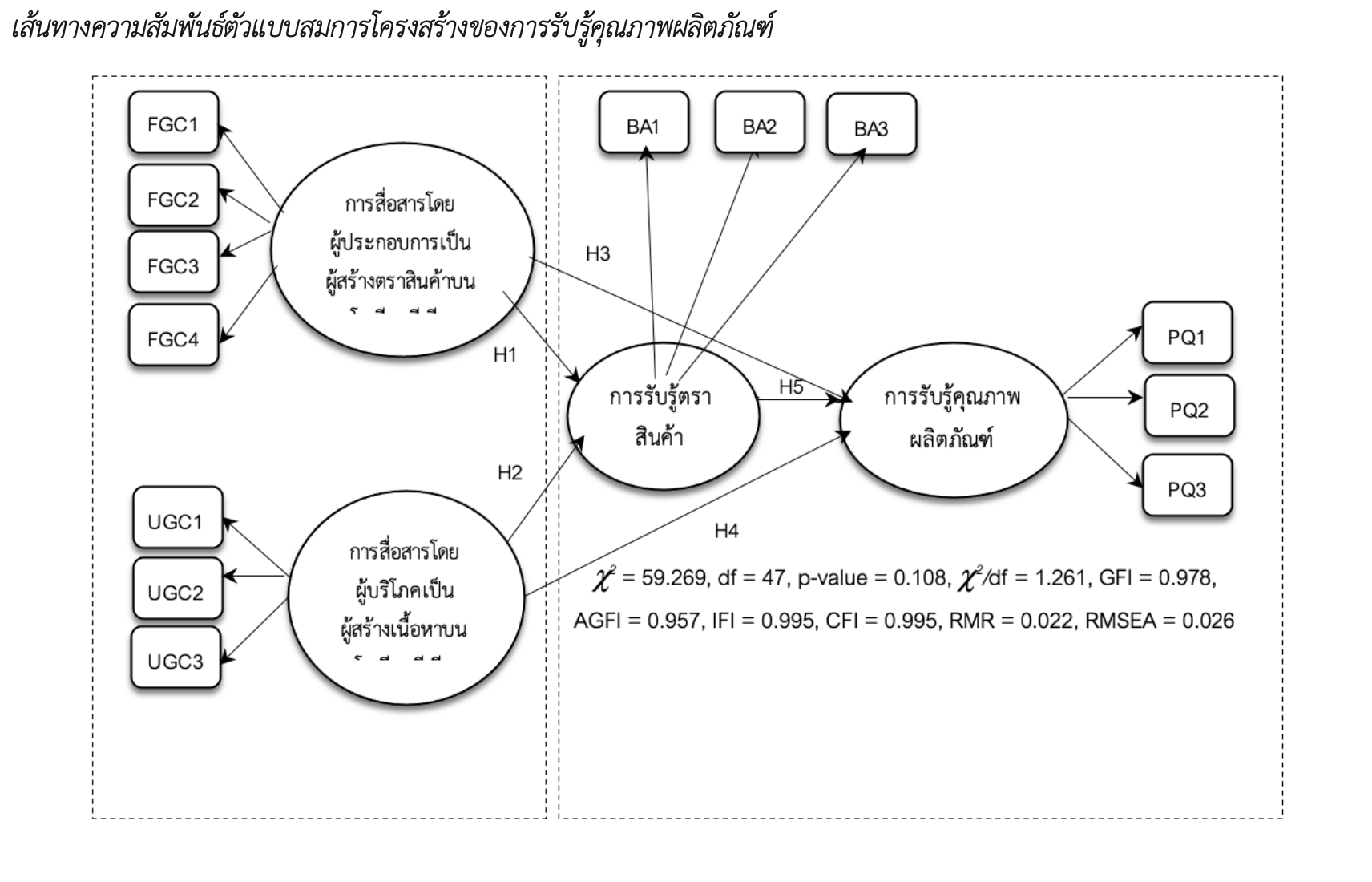อิทธิพลของการสื่อสารโดยผู้ประกอบการเป็นผู้สร้างตราสินค้าบนโซเชียลมีเดียและการสื่อสารโดยผู้บริโภคเป็นผู้สร้างเนื้อหาบนโซเชียลมีเดียส่งผลต่อการรับรู้คุณภาพผลิตภัณฑ์
Main Article Content
บทคัดย่อ
การวิจัยครั้งนี้มีวัตถุประสงค์ เพื่อศึกษาโมเดลการรับรู้คุณภาพผลิตภัณฑ์ ที่เกิดจากการสื่อสารโดยผู้ประกอบการเป็นผู้สร้างตราสินค้าบนโซเชียลมีเดีย การสื่อสารโดยผู้บริโภคเป็นผู้สร้างเนื้อหาบนโซเชียลมีเดียและการรับรู้ตราสินค้า เป็นการวิจัยเชิงปริมาณ ศึกษาจากกลุ่มผู้ซื้อสินค้าบนโซเชียลมีเดีย 400 คน เก็บข้อมูลด้วยวิธีการแบบบอกต่อ (Snowball sampling) วิเคราะห์ตัวแบบสมการโครงสร้าง (SEM) ด้วยโปรแกรม AMOSผลการวิจัยพบว่าการสื่อสารโดยผู้ประกอบการเป็นผู้สร้างตราสินค้าบนโซเชียลมีเดีย การสื่อสารโดยผู้บริโภคเป็นผู้สร้างเนื้อหาบนโซเชียลมีเดีย และการรับรู้ตราสินค้าส่งผลทางตรงต่อการรับรู้คุณภาพผลิตภัณฑ์ อย่างมีนัยสำคัญทางสถิติ (p < .05) โดยปัจจัยที่มีขนาดอิทธิพลรวม (Total effect) ต่อการรับรู้คุณภาพผลิตภัณฑ์มากที่สุด คือ การรับรู้ตราสินค้า (TE=0.691) รองลงมา การสื่อสารโดยผู้ประกอบการเป็นผู้สร้างตราสินค้าบนโซเชียลมีเดีย (TE = 0.333) และการสื่อสารโดยผู้บริโภคเป็นผู้สร้างเนื้อหาบนโซเชียลมีเดีย (TE = 0.198) ตามลำดับ โดยทั้ง 3 ปัจจัยร่วมกันพยากรณ์การรับรู้คุณภาพผลิตภัณฑ์ได้ร้อยละ 52.8 (R2 = 0.528)
Article Details

อนุญาตภายใต้เงื่อนไข Creative Commons Attribution-NonCommercial-NoDerivatives 4.0 International License.
** ข้อความ ข้อคิดเห็น หรือข้อค้นพบ ในวารสารสหวิทยาการสังคมศาสตร์และการสื่อสารเป็นของผู้เขียน ซึ่งจะต้องรับผิดชอบต่อผลทางกฎหมายใด ๆ ที่อาจเกิดขึ้นจากบทความและงานวิจัยนั้น ๆ โดยมิใช่ความรับผิดชอบของคณะนิเทศศาสตร์ มหาวิทยาลัยราชภัฏรำไพพรรณี **
เอกสารอ้างอิง
Aaker, D.A. (1996). Measuring brand equity across products and markets. CA Management Review, 38(3):102-120.
Arnold, M.J. and Reynolds, K.E. (2003). Hedonic shopping motivations. Journal of Retailing, 79(2):77-95.
Bruhn, M., Schoenmueller, V., & Schafer, D.B. (2012). Are social media replace traditional media in terms of brand equity creation?. Management Research Review, 35(9).
Bruhn, M., Schnebelen, S., & Schafer, D. (2013). Antecedents and consequences of the quality of e-customer-to-customer interaction in B2B brand communities. Industrial marketing management, 43(1).
Cleary, J. and Bloom, T. (2011). Gatekeeping at the portal: an analysis of local television websites’ user-generated content, Electronic News, Vol.5 (2):93-111.
Cyr, D., Head, M., & Ivanov, A. (2009). Perceived interactivity leading to e-loyalty: Development of model cognitive-affective user response. Interaction Journal of Human-computer studies, 67: 850-869.
Kaplan, A.M. & Haenlein, M. (2010). User of the world, unite! The challenges and opportunities of social media. Business Horizons, 53(1):59-68.
Keller, K.L. (1993). Conceptualizing, measuring, managing customer-based brand equity. Journal of Marketing, 57(1):1-22.
Morra, M. C., Ceruti, F., Chierici, R., & Gregorio, A. D. (2017). Social vs traditional media communication: brand origin associations strike a chord. Journal of Research in interactive marketing, 12(1):2-21.
Oliver, R. (1997). Satisfaction: A Behavioral Perspective on the consumer, McGraw-Hill, New York, NY.
Rao, A.R. & Monroe, K.B. (1989). The effect of price, brand name, and store name on buyers’ perceptions of product quality: an integrative review. Journal of Marketing Research, 36(2):351-358.
Rossiter, J.R., & Percy, L. (1987). Advertising and Promotion Management. McGraw-Hill Book Company, New York.
Santos, M. L. B. (2021). The so-called UGC: an updated definition of user-generated content in the age of social media. Online information review,
Schivininski, B., & Dabrowski, D. (2014). The impact of brand communication on brand equity through Facebook. Journal of Research in Interactivity Marketing, 9(1):31-53.
Seo, E-J., & Park, J-W. (2018). A study on the effects of social media marketing activities on brand equity and customer response in the airline industry. Journal of Air Transport Management, 66: 36-41.
Sethan, B.N., Hazari, S., & Bergiel, B. (2017). Influence of user generated content in online shopping: impact of gender on purchase behavior, trust, and intention to purchase. Int. J. Electronic Marketing and Retailing, 8(4).
Tran, T.P., Lin, C-W., Baalbaki, S., & Guzman, F. (2020). How personalized advertising affects equity of brands advertised on Facebook? A mediation mechanism, 120: 1-15.
Yoo, B. & Donthu, N. (2001). Developing and validating a multidimensional consumer-based brand equity scale. Journal of Business Research, 52(1):1-14.
Yoo, C., Park, J. & MachInnis, D.J. (1998). Effects of store characteristics and in-store emotional experiences on store attitude. Journal of Business Research, 42(3):253-263.
William, R., Madden, T.J., Krimani, A., & Mukherjee, S. (2001). Understanding what’s in a brand rating: a model for assessing brand and attribute effects and their relationship to brand equity. Journal of Marketing Research, 38: 415-429.


